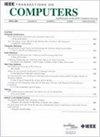Big-Computing and Little-Storing STT-MRAM PIM Architecture With Charge Domain Based MAC Operation
IF 3.6
2区 计算机科学
Q2 COMPUTER SCIENCE, HARDWARE & ARCHITECTURE
引用次数: 0
Abstract
Spin transfer torque magnetic random access memory (STT-MRAM) is a promising memory technology for processing in memory (PIM) thanks to its high endurance and relatively low device-to-device and cycle-to-cycle variations. However, the low OFF/ON ratio of STT device limits the number of active row-lines during multiply-accumulate (MAC) operations, degrading energy efficiency and computation speed. In this paper, we present an energy efficient and high speed Big-computing and Little-storing STT-MRAM PIM (BCLS-SP) architecture, which can increase the number of active row-lines with almost no area overhead. In the BCLS-SP architecture, a charge domain-based STT-MRAM PIM (CD-SP) structure is employed to concurrently activate many row-lines by improving MAC operation reliability. Filter-wise weight compression (FWC) and weight sharing (WS) are also devised to compress the weights stored in CD-SP, thus reducing area cost. In addition, the proposed architecture performs MAC operations with skipping zero-valued input (SZI) and zero-conversion scheme (ZCS) for better energy efficiency and performance. The simulations using 28nm CMOS process show that the BCLS-SP architecture shows energy reduction of 29% and performance improvement of 3.6 compared to the recent memristive device-based PIM using weight compression and input skipping.求助全文
约1分钟内获得全文
求助全文
来源期刊

IEEE Transactions on Computers
工程技术-工程:电子与电气
CiteScore
6.60
自引率
5.40%
发文量
199
审稿时长
6.0 months
期刊介绍:
The IEEE Transactions on Computers is a monthly publication with a wide distribution to researchers, developers, technical managers, and educators in the computer field. It publishes papers on research in areas of current interest to the readers. These areas include, but are not limited to, the following: a) computer organizations and architectures; b) operating systems, software systems, and communication protocols; c) real-time systems and embedded systems; d) digital devices, computer components, and interconnection networks; e) specification, design, prototyping, and testing methods and tools; f) performance, fault tolerance, reliability, security, and testability; g) case studies and experimental and theoretical evaluations; and h) new and important applications and trends.
 求助内容:
求助内容: 应助结果提醒方式:
应助结果提醒方式:


